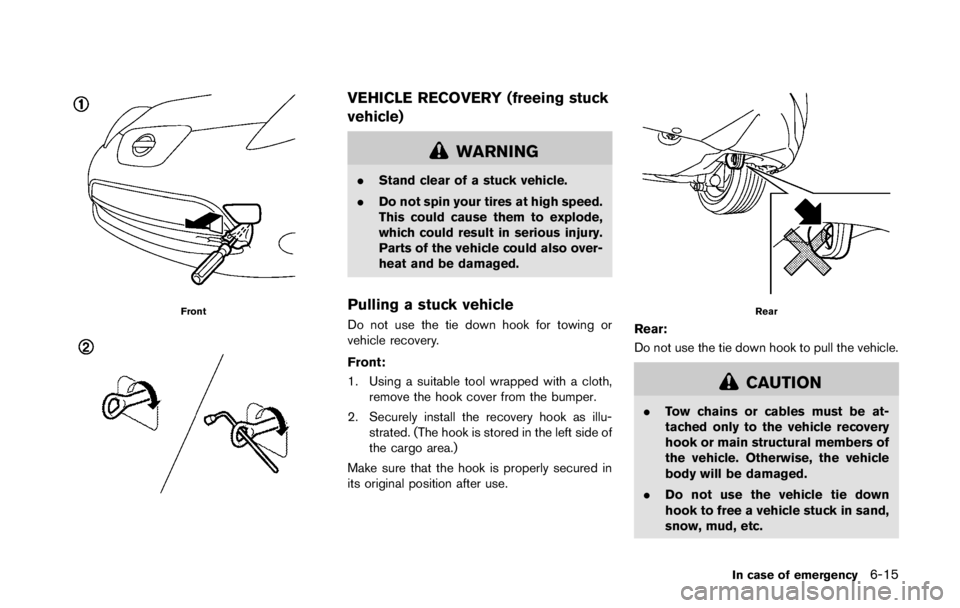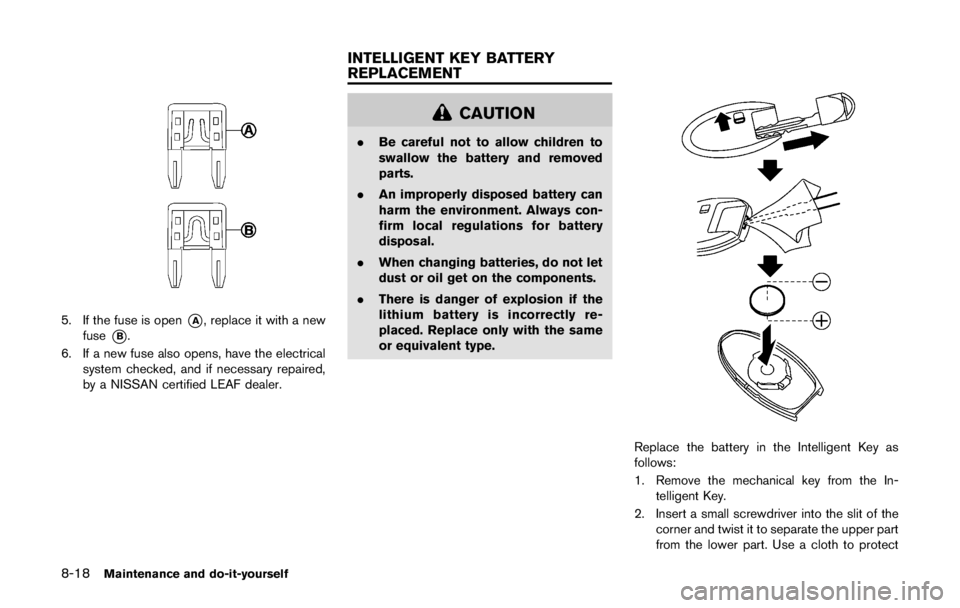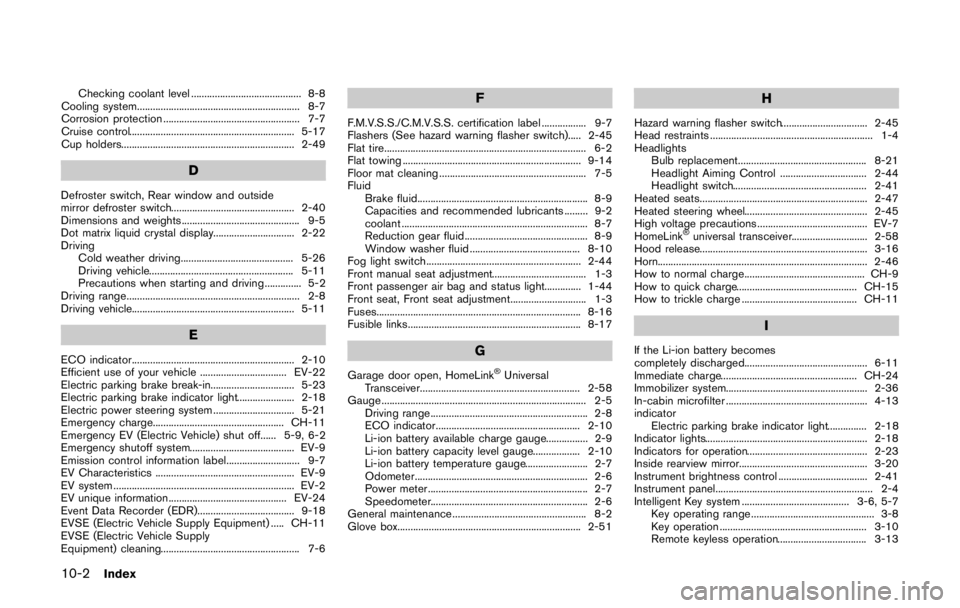2011 NISSAN LEAF warning light
[x] Cancel search: warning lightPage 278 of 1062

EMERGENCY SHUT-OFF SYSTEM
The emergency shut-off system is activated and
the high-voltage system automatically turns off in
the following conditions:
- Front and side collisions in which the air bags
are deployed.
- Certain rear collisions.
- Certain EV (Electric Vehicle) system malfunc-
tions
For the above collisions and certain other EV
(Electric Vehicle) system malfunctions, the
READY to drive indicator light will turn off. See
“Warning/indicator lights and audible remin-
ders” in the “2. Instruments and controls”
section.
The emergency shut-off activates for the above
collisions to minimize risk of an event that could
cause injury or an accident. If the emergency
shut-off system activates, the EV system may
not be switched to READY to drive position,
contact a NISSAN certified LEAF dealer. Even if
the power switch is switched to READY to drive
position, the system may shut-off suddenly.
Therefore, drive cautiously to the nearest
NISSAN certified LEAF dealer or contact a
NISSAN certified LEAF dealer as soon as
possible.WARNING
.Pay special attention to pedes-
trians. Because there is no engine
noise, pedestrians may not know
the vehicle is approaching, moving
or about to move, and may step into
the path of vehicle travel.
. When leaving the vehicle, be sure to
turn off the EV (Electric Vehicle)
system.
. Be sure to push the P (Park) posi-
tion switch on the selector lever and
apply the parking brake when park-
ing because the vehicle can move
when the READY to drive indicator
light is ON. When the READY to
drive indicator light is ON, do not
leave your vehicle in a shift position
other than the P (Park) position.
. Keep the brake pedal depressed
until you are ready to drive. When
the vehicle is in the D (drive) posi-
tion or ECO or R (reverse) position,
if you release the brake pedal and
do not depress accelerator, the
vehicle will creep and may start
abruptly. This may cause serious injury or death.
NOTE:
. The vehicle cannot run with a dis-
charged Li-ion battery. Repeated accel-
eration consumes more power from the
Li-ion battery than driving at a steady
speed.
. This vehicle is equipped with a regen-
erative brake system. The primary pur-
pose of regenerative brake system is to
provide some power to recharge the Li-
ion battery and extend driving range. A
secondary benefit is “engine braking”
that operates based on Li-ion battery
conditions.
. In the D (Drive) position, when the
accelerator pedal is released, the re-
generative brake system provides
some deceleration.
. When you put the shift selector in the
ECO position and take your foot off the
accelerator pedal, more regenerative
brake is applied than in the D (Drive)
position.
. Less deceleration is provided by the
regenerative brake system when the Li-
EV OverviewEV-9
EV (Electric Vehicle)
CHARACTERISTICS
Page 291 of 1062

4. When activated, the hazard warning lightswill flash twice. When deactivated, the
hazard warning lights will flash once.
5. The power switch must be placed in the OFF and ON position again between each
setting change.
When the automatic door unlock system is
deactivated, the doors do not unlock when the
power is placed in the OFF position. To unlock
the door manually, use the inside lock knob or
the power door lock switch (driver’s or front
passenger’s side).
Page 307 of 1062

battery may be discharged or there
may be a malfunction in the 12-volt
battery related system.
— If the 12-volt charge warning light
continues to illuminate when the
vehicle is in the READY to drive
mode, there may be a malfunction in
the DC/DC converter. Contact a
NISSAN certified LEAF dealer for
inspection.
Page 331 of 1062

WARNING
.If you use any medical electric
devices, such as an implantable
cardiac pacemaker or an implanta-
ble cardiovascular defibrillator,
check with the electric medical de-
vice manufacturer concerning the
effects that charging may have on
implanted devices before starting
the charge operation. Charging
may affect the operation.
. If you have an implantable cardiac
pacemaker or an implantable cardi-
ovascular defibrillator, while the Li-
ion battery is charging:
— Do not stay inside the vehicle.
— Do not go inside the vehicle, for
example to remove or place an
item in the passenger compart-
ment.
— Do not open the rear hatch, for example to remove or place an
item in the cargo area.
Charging may affect the operation
of electric medical device and result
in serious personal injury or death. .
Make sure there is no water or
foreign materials in the charge port,
charge connector or electrical plug,
and that they are not damaged or
affected by rust or corrosion. If any
of these conditions are noticeable,
do not charge the Li-ion battery.
This may result in a short circuit or
electric shock and could cause a fire
which may result in serious perso-
nal injury or death.
. To avoid serious personal injury or
death when the Li-ion battery is
charging, be aware of the following
precautions.
— Do not touch the metal contacts
of the charge port, charge con-
nector or electrical plug.
— Do not touch the vehicle and charger when there is lightning.
A lightning strike may back feed
into the charger causing da-
mage and possible personal in-
jury or death.
. Make sure the charge connector is
removed from the charge port be-
fore starting your vehicle. If the
charge connector is only partially engaged and the connector latch is
unlocked, it is possible to place the
EV (Electric Vehicle) in the READY
to drive position.
. Do not plug in or unplug the plug
with wet hands and do not stand in
water, liquid or snow. This may
cause an electric shock which may
result in serious personal injury or
death.
. Do not disassemble or modify the
charge port or the EVSE (Electric
Vehicle Supply Equipment) . This
may cause a fire.
. If you notice an unusual odor or
smoke coming from the vehicle,
stop charging immediately.
. Be careful not to allow your hands,
hair, jewelry or clothing to come into
contact with, or get caught in, the
traction motor cooling fan. The cool-
ing fan can start at any time during
charging.
PRECAUTIONS ON CHARGING
Page 338 of 1062

WARNING
.The front air bags ordinarily will not
inflate in the event of a side impact,
rear impact, rollover or lower sever-
ity frontal collision. Always wear
your seat belts to help reduce the
risk or severity of injury in various
kinds of accidents.
. The front passenger air bag will not
inflate if the passenger air bag
status light is lit or if the front
passenger seat is unoccupied. See
“Front passenger air bag and status
light” later in this section.
. The seat belts and the front air bags
are most effective when you are
sitting well back and upright in the
seat with both feet on the floor. The
front air bags inflate with great
force. Even with the NISSAN Ad-
vanced Air Bag System, if you are
unrestrained, leaning forward, sit-
ting sideways or out of position in
any way, you are at greater risk of
injury or death in a crash. You may
also receive serious or fatal injuries
from the front air bag if you are up
Safety—Seats, seat belts and supplemental restraint system1-37
Page 344 of 1062

your NISSAN certified LEAF dealer
to check the occupant classification
system.
. Until you have confirmed with your
dealer that your passenger seat
occupant classification system is
working properly, position the occu-
pants in the rear seating positions.
This vehicle is equipped with the NISSAN
Advanced Air Bag System for the driver and
front passenger seats. This system is designed
to meet certification requirements under U.S.
regulations. It is also permitted in Canada.
However, all of the information, cautions
and warnings in this manual still apply and
must be followed.
The driver supplemental front-impact air bag is
located in the center of the steering wheel. The
passenger supplemental front-impact air bag is
mounted in the instrument panel above the glove
box. The front air bags are designed to inflate in
higher severity frontal collisions, although they
may inflate if the forces in another type of
collision are similar to those of a higher severity
frontal impact. They may not inflate in certain
frontal collisions. Vehicle damage (or lack of it) is
not always an indication of proper front air bag
operation. The NISSAN Advanced Air Bag System has
dual stage air bag inflators. The system monitors
information from the Air bag Control Unit (ACU) ,
seat belt buckle sensors and the occupant
classification sensors (weight sensors) . Inflator
operation is based on the severity of a collision
and seat belt usage for the driver. For the front
passenger, the occupant classification sensors
are also monitored. Based on information from
the sensors, only one front air bag may inflate in
a crash, depending on the crash severity and
whether the front occupants are belted or
unbelted. Additionally, the front passenger air
bag may be automatically turned OFF under
some conditions, depending on the information
provided by the occupant classification sensors.
If the front passenger air bag is OFF, the
passenger air bag status light will be illuminated
(if the seat is unoccupied, the light will not be
illuminated, but the air bag will be off) . See
“Front passenger air bag and status light” later
in this section for further details. One front air
bag inflating does not indicate improper perfor-
mance of the system.
If you have any questions about your air bag
system, contact NISSAN or a NISSAN certified
LEAF dealer. If you are considering modification
of your vehicle due to a disability, you may also
contact NISSAN. Contact information is con-
tained in the front of this Owner’s Manual.
When a front air bag inflates, a fairly loud noise
may be heard, followed by release of smoke.
This smoke is not harmful and does not indicate
a fire. Care should be taken not to inhale it, as it
may cause irritation and choking. Those with a
history of a breathing condition should get fresh
air promptly.
Front air bags, along with the use of seat belts,
help to cushion the impact force on the head
and chest of the front occupants. They can help
save lives and reduce serious injuries. However,
an inflating front air bag may cause facial
abrasions or other injuries. Front air bags do
not provide restraint to the lower body.
Even with NISSAN Advanced Air Bags, seat
belts should be correctly worn and the driver
and passenger seated upright as far as practical
away from the steering wheel or instrument
panel. The front air bags inflate quickly in order
to help protect the front occupants. Because of
this, the force of the front air bag inflating can
increase the risk of injury if the occupant is too
close to, or is against, the air bag module during
inflation.
The front air bags deflate quickly after a collision.
Safety—Seats, seat belts and supplemental restraint system1-43
Page 345 of 1062

The front air bags operate only when the
power switch is in the ON position.
After the power switch is placed in the ON
position, the supplemental air bag warning
light illuminates. The supplemental air bag
warning light will turn off after about 7
seconds if the system is operational.
Page 347 of 1062

If the passenger air bag status light will not
illuminate even though you believe that the child
restraint, the seat belts and the occupant are
properly positioned, the system may be sensing
an unoccupied seat (in which case the air bag is
OFF). Your NISSAN certified LEAF dealer can
check that the system is OFF by using a special
tool. However, until you have confirmed with
your dealer that your air bag is working properly,
reposition the occupant or child restraint in a
rear seat.
The air bag system and passenger air bag status
light will take a few seconds to register a change
in the passenger seat status. However, if the
seat becomes unoccupied, the air bag status
light will remain off.
If a malfunction occurs in the front passenger air
bag system, the supplemental air bag warning
light